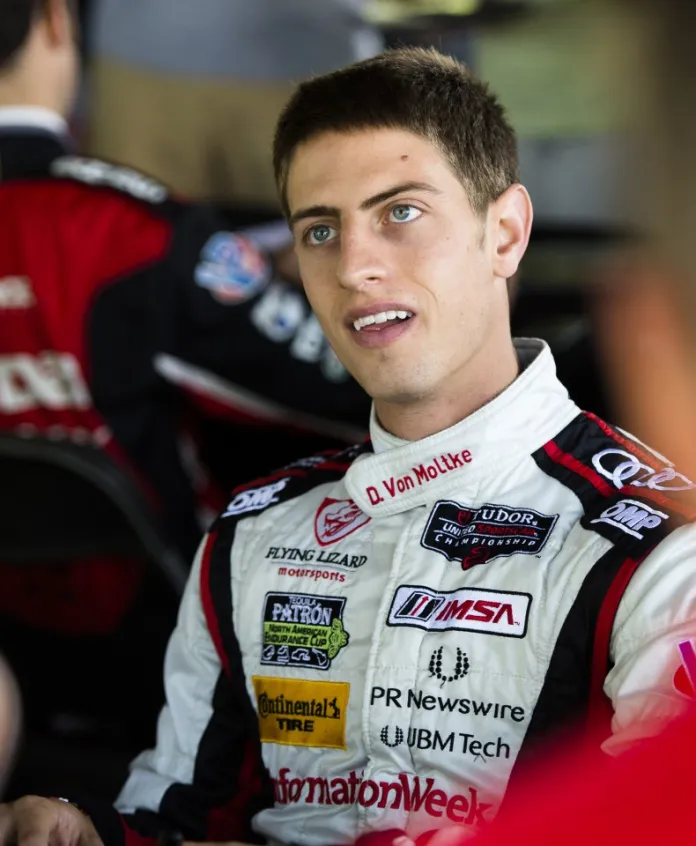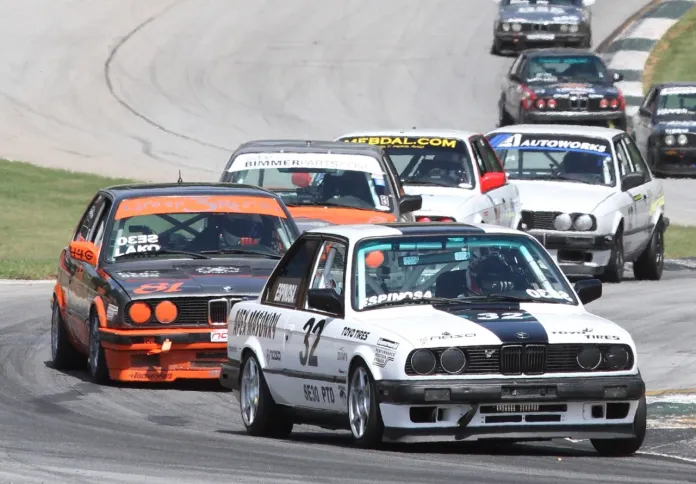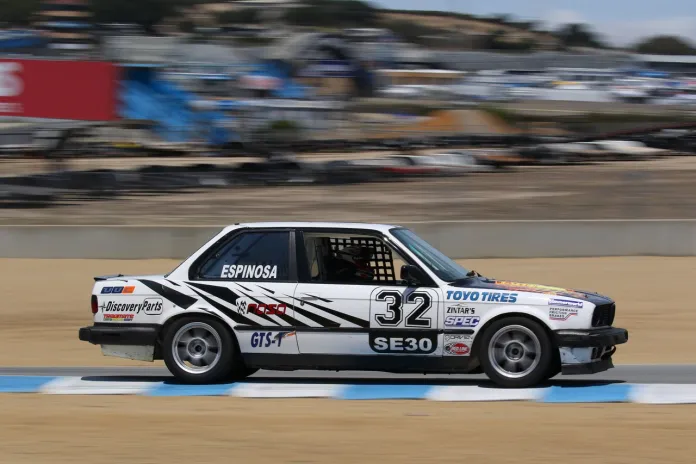Walking the tightrope: a poetic way to convey the feeling one has when trying to roll those last few miles an hour into a long corner that challenges both axles.
We’ve all learned how to go in slow and exit fast, but fast drivers enter fast, exit fast, and keep their minimum speeds from dropping much. The best in the world have an innate ability to keep the car moving ahead without interruption, with no major departures off the intended line, no time-sapping snaps of oversteer, and no lollygagging when it’s time to get back to throttle. How can they constantly drive at the edge and keep it pointed in the right direction at all times?

It all begins with a plan. As Blayze.io president Dion Von Moltke says, “Determining the most important phase of the corner is the first step.” For example, the prioritized portion of a long corner without a long straightaway before or after is its mid-section.
Long corners, especially the faster ones, reward a gentler speed change. This means getting off the brakes sooner and keeping minimum speed up — mainly to keep the rear of the car from sliding much, because big snaps are harder to catch at higher speeds. There’s another reason to do this: the faster the corner, the less the exit generally matters. Most of the speed is found into and through the middle of the bend. This is especially true in cars with little horsepower.
Sandro Espinosa, a talented Georgia-based businessman who’s raced most things under the sun, has two approaches to maintaining minimum speed through this type of corner. When driving a momentum car, one that doesn’t recover easily from a midcorner mistake because it lacks power, he utilizes a non-textbook technique.
“With a Spec E30, I like to induce a little oversteer into the corner,” Espinosa said. “The slide is easy enough to catch. The main reason I do this is because I get pointed in the right direction faster, and this allows me to get to throttle a little faster. After I’ve done the downshifting, I have my left foot hovering over the brake pedal and go flat with my right. If I feel the car start to understeer, I don’t lift off the gas since conserving momentum is so important. Instead, I try to rub the brake to put a little more weight on the front axle.“

With higher horsepower cars, the approach changes a lot. The stiffer suspension that usually accompanies more horsepower means faster weight transfer, and so a midcorner lift is best avoided lest a snap occur. Obviously, one can’t go full-throttle in the middle of a slow or medium-speed corner when there’s so much power available, so Sandro avoids the two-footed technique and relies on a measured throttle application.
While sensitivity for the pedal position is important in any car, the need to avoid big power-slides requires a little restraint. The driver cannot experiment so much at the edge as they might in a Miata. Therefore, if the throttle pedal is treated more like a light switch in a car with more grip than power, the loud pedal in the overpowered car is much more like a dimmer switch. To avoid upsetting the powerful car’s rear and deploying as much of that power as possible, one needs a committed, progressive throttle application.
Getting comfortable with a small amount of power oversteer is necessary, as did Sandro Espinosa in Ferrari Challenge, a high-horsepower series that required him to shift his mentality from his all-momentum Spec E30.
A preemptive caution is necessary in regard to what the driven wheels will accept at various stages of the corner, but even so, the drivers will inevitably exceed the rear’s limit, and when that happens, they have to be a little more delicate with their throttle inputs. The way they massage the pedal to maintain the balance without exacerbating wheelspin. This sensitivity requires time and enough experience to remain analytical while sliding, but it can be harnessed and felt with time.
“To get a feel for the front end, it takes a couple laps of light pushing. The first should be done with a little caution, since the tires are cold. Then next lap, push a little harder. By the third, you should have a decent idea of where the limit is,” Espinosa says.
This measured yet assertive style of driving reveals enough to give a good sense of how much stick is available without putting the driver in a predicament.

Take Buttonwillow’s Riverside: a high-speed, increasing-radius left that most cars will navigate at or around a hundred miles an hour. A little understeer through this corner is expected — in fact, it’s something that many accept as an inevitable part Riverside.
Obviously, the corner is too fast to negotiate with any significant oversteer, though the special guys might be able to get away with it a few times, but that doesn’t mean a long lull through the middle of the corner is inevitable. “Carry enough speed, make sure you’re looking in the right place, and drive the car with the pedals,” Dion instructs.
In a stiff car with lots of grip, this usually means a smooth release of the throttle to trace the intended line, though a softer car with less stick might actually benefit from a rub of the brake. In either case, a hasty but delicate reapplication of the gas is needed soon thereafter to stabilize the rear. Since the corner is fast and the amount of speed change needed is small, it has to be done relatively quickly and with near-perfect timing. Then, once the intended trajectory is obtained, the throttle needs to be reapplied to settle the rear and prevent a sphincter-squeezer of a snap.
Watch Brett Smrz navigates this turn in a nicely prepped BMW M3 with stiff suspension and aero at more than 100 miles an hour. As he starts to feel the front starting to wash away (3:14), he releases the throttle to help the car turn and return to the ideal line. We can even see him countersteer briefly as the throttle is released. The rear is starting to slide ever so slightly. He then feels the front bite and applies some stabilizing throttle as he steers in more to regain the line he’s just slid a couple feet away from.
He repeats this subtle see-sawing several times more before exiting Riverside, every time careful to arrest any slides at the rear before they get out of hand. He feels the front fade, releases the throttle, then once he’s back nearer his intended line, he stabilizes the car with a dab of gas to plant the rear. It’s all done with such precision and commitment that it hardly looks like he’s steering, and that’s because he really isn’t — his feet are responsible for the direction changes.
“Some drivers will roll through a high-speed, steady-state cornering situation and just blindly accept that the car will understeer,” says Von Moltke. “The key is to carry enough speed in so that the understeer can be minimized, but there’s more to it than that. It’s not just about rolling enough speed — you have to harness that extra momentum with the right sort of weight transfer to help it turn.”
The way the throttle and brake are manipulated change somewhat when the shape of the corner tightens. In a long, fast corner like Buttonwillow’s Riverside, the inputs must be very subtle and the throttle curve is fairly flat. In a tighter corner like Laguna Seca’s Turn 2, a more dynamic corner, the approach is slightly different.
Turn 2, a relatively slow corner that happens to go on a while, is preceded by a long straight. Speeds are high on entry, which means the weight transfer available is significant. The braking zone can and should be pushed relatively late into the corner, which allows for a more pronounced direction change.
Charging in with slightly more speed past the first apex, then a slightly slower rate of brake release, or even a split-second dab of the brake pedal can unload the rear long enough to encourage a little more yaw. This is feasible because the corner is slower, and because it’s tighter than Riverside. It needs a little more mid-corner “bending” to get it pointed at the second apex sooner, which shortens the corner slightly and allows an earlier throttle application.










